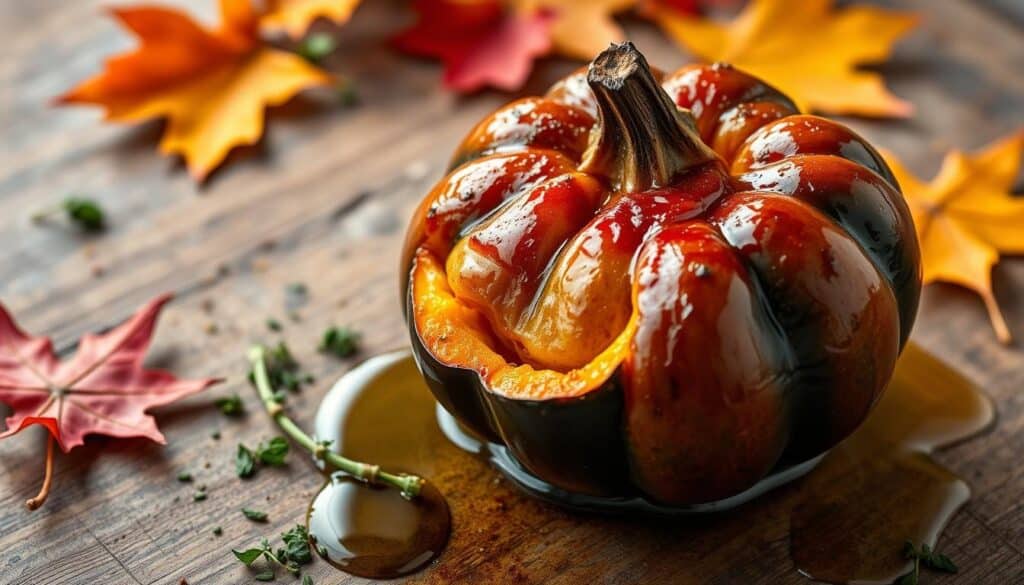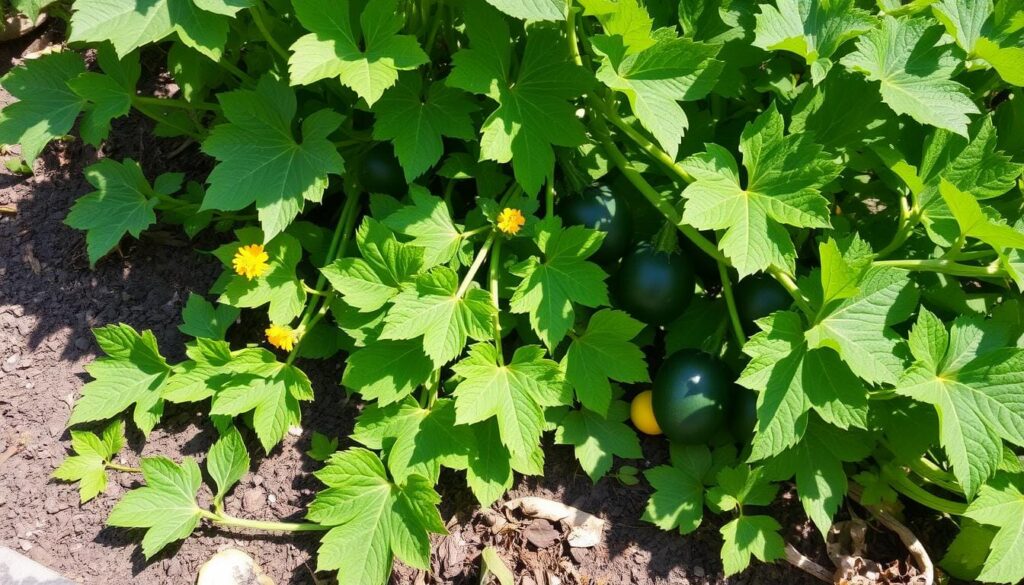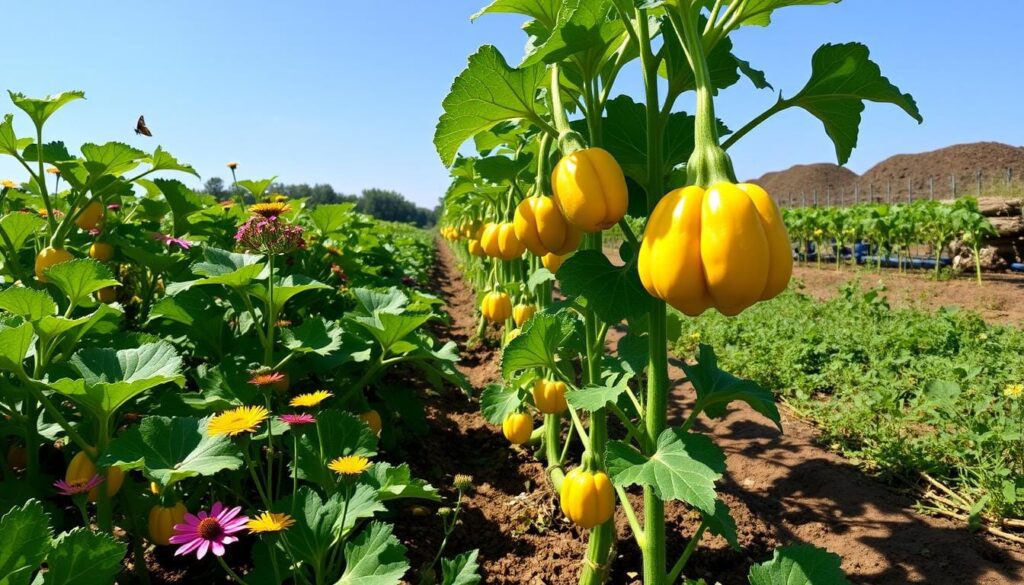As autumn arrives, the air grows crisp and leaves turn colors. Our senses come alive, eager for hearty, seasonal foods. Among our favorites is the acorn squash, a fall delicacy.
But how do we know when an acorn squash is ripe? In our home, we’ve learned to pick the perfect squash. The difference between an underripe and ripe squash can change a dish’s flavor.
So, we’re excited to share our tips for finding the ripest acorn squash. This way, you can enjoy the best flavor and texture in your dishes.
Key Takeaways
- Acorn squash are typically harvested 80-100 days after planting.
- Look for a dark green color with an orange “ground spot” on the skin.
- The rind should be tough and resistant to fingernail pressure.
- The stem should be dry and shriveled, indicating full maturity.
- Properly ripened acorn squash offer superior flavor, texture, and storage life.
Understanding Acorn Squash Varieties
Acorn squash comes in a wide range of colors and sizes. You can find them in deep green, white ‘Mashed Potatoes’, and vibrant orange. They usually weigh 1 to 3 pounds and are 5 to 8 inches long. Their acorn shape and ridged skin make them stand out.
Types of Acorn Squash We Might Encounter
- Table Queen Acorns: A popular variety that matures in around 80 days, offering a relatively fast growth period compared to other winter squash.
- Classic Green Acorn Squash: The quintessential acorn squash, with a deep green hue and delightful flavor.
- White ‘Mashed Potatoes’ Acorn Squash: A unique and visually striking variety with a creamy white exterior.
- Orange-Tinged Acorn Squash: These squashes develop a vibrant orange spot on the bottom side as they ripen, signaling their readiness for harvest.
Color Variations and Their Significance
The color of an acorn squash tells us a lot about its ripeness. As it matures, it turns deep green with a yellow-gold to dark-orange spot on the bottom. This color change means it’s ready to be picked, ensuring it’s full of flavor and sweetness.
Size and Shape Characteristics
Acorn squash are usually 5 to 8 inches long and 4 to 5 inches wide when they’re fully grown. But, size can vary depending on the variety and where they’re grown. Their acorn shape and ridged skin make them easy to spot and beautiful to look at.
“Acorn squash are fully ripe between 80 and 100 days after transplanting the seedlings into the vegetable garden,” notes Rebecca Sears, a gardening expert.
The Importance of Ripeness
Ripeness is key to getting the best taste, texture, and health benefits from acorn squash. When it’s fully ripe, it tastes sweet and has a creamy texture. This is much better than when it’s not ripe yet.
How Ripeness Affects Flavor and Texture
A ripe acorn squash tastes deep and sweet, unlike unripe squash which can taste bland or bitter. The flesh gets soft and velvety, making it a pleasure to eat. This ensures we get to enjoy its natural sweetness and complex flavors fully.
Nutritional Benefits of Ripe Acorn Squash
- Ripe acorn squash is packed with vitamins A and C, giving over 30% of what we need in one serving.
- It’s also full of fiber, potassium, and antioxidants, which are great for our health.
- Compared to unripe squash, ripe squash has more of these important nutrients, making it super nutritious.
Getting acorn squash ripe not only makes it taste and feel better. It also makes it more nutritious, letting us enjoy all its health benefits.
“The difference in flavor and texture between a ripe and unripe acorn squash is night and day. Ripe squash is simply a joy to cook with and eat.”
Signs of Ripe Acorn Squash
Choosing the right acorn squash is important. We want it to be tasty, full of nutrients, and ready for cooking. Let’s look at how to tell if an acorn squash is ripe.
Skin Color and Appearance
Ripe acorn squash has a deep, dark green skin. It should have an orange ground spot on one side. The rind should be dull, not shiny, and hard to press with your fingernail.
Stay away from squash with soft spots or too much orange color. This means it’s overripe.
Stem Condition and Texture
The stem is another clue. A ripe acorn squash has a dry, shriveled stem that comes off easily. The stem should not be green and moist, which means it was picked too soon.
Weight and Firmness
Look for a squash that feels heavy for its size and is firm. A gentle squeeze should show it’s hard. Avoid squash that are light or have soft spots. These are signs of immaturity or overripeness.
By using these signs, you can pick the best acorn squash. With the right ripeness, you’ll enjoy its full flavor and nutritional benefits.
“The perfect acorn squash should have a deep, dark green skin and an orange ground spot on one side. It should also feel heavy and have a dry, shriveled stem.”
When to Harvest Acorn Squash
Timing is key when picking acorn squash. Most types are ready 75-100 days after planting, usually in September or October. This is before the first frost. They grow best in full sun and well-draining soil, with temperatures between 70-90°F.
Ideal Growing Conditions
Acorn squash needs 6-8 hours of direct sunlight daily. They also do well in rich, well-draining soil. Use balanced fertilizer at planting and more potassium and phosphorus when the squash grows.
The Role of Season and Climate
The harvest time depends on the season and climate. In longer seasons, squash is ready around 80 days. But in shorter seasons, wait 100 days or more for full maturity.
Timing for Maximum Sweetness
For the sweetest squash, harvest at the right time. The starch and dry matter peak 30-35 days after pollination. Full maturity is 55 days later. Harvesting 75-100 days after planting ensures the sweetest flavor.
Knowing the best growing conditions, seasonal factors, and timing for sweetness leads to a great harvest. With proper care, you’ll enjoy the rich flavor of acorn squash soon.
How to Store Acorn Squash
Storing acorn squash right is crucial to keep it fresh and tasty. To make sure your acorn squash stays good for a long time, follow these tips:
Best Storage Practices
The best spot for acorn squash is a cool, dry area with temperatures between 50-55°F. Unlike other winter squash, acorn squash doesn’t need curing before storing. Place the squash in a single layer to stop rot or decay.
Don’t store acorn squash with fruits like apples and pears. The gas they produce can make the squash spoil faster. With the right storage, your acorn squash can last up to 2 months.
Environmental Conditions to Consider
- Temperature: 50-55°F
- Humidity: 50-70%
- Ventilation: Good air flow to prevent moisture buildup
- Avoid storage with ethylene-producing fruits
Always check your acorn squash for any signs of spoilage, like soft spots or mold. By following these acorn squash storage tips, you can enjoy its flavor and versatility for weeks.
Cooking with Ripe Acorn Squash
Acorn squash is great for many tasty dishes. Look for a ripe one with a dark green, dull skin and a firm, heavy feel. These signs mean it’s ready to be cooked into delicious meals.
Popular Recipes to Try
Roasting ripe acorn squash with brown sugar, butter, and spices like cinnamon is a classic. The squash’s natural sweetness pairs well with these flavors. For a savory dish, stuff the squash halves with sausage, breadcrumbs, and herbs.
Acorn squash is also great in place of pumpkin in pies, soups, and other fall dishes. Its nutty taste works well with both sweet and savory ingredients, making it a kitchen favorite.
Cooking Methods That Highlight Flavor
- Roasting: Slice the squash, toss with oil, salt, and pepper, then roast at 400°F until tender and caramelized.
- Baking: Halve the squash, scoop out the seeds, and bake until the flesh is soft and creamy.
- Stuffing: Fill the cavity of a halved squash with a savory or sweet mixture, then bake until heated through.
Preparing ripe acorn squash in any way adds a burst of flavor to your dishes. Its unique texture and sweetness are perfect for both sweet and savory recipes.
| Nutritional Information | Ingredients |
|---|---|
|
|

When picking and preparing acorn squash, look for a heavy squash with a deep green, dull skin. Avoid those with too much orange, as they’re overripe. The right cooking methods will bring out the squash’s full flavor.
Troubleshooting Common Issues
Acorn squash can sometimes be tricky to deal with. Let’s look at common problems and how to fix them.
Identifying Under-ripe Acorn Squash
An under-ripe acorn squash looks lighter green and has a soft rind. The inside is less sweet and starchy. If you find an unripe squash, you can ripen it in a warm, sunny place for a few days to a week.
Dealing with Overripe Acorn Squash
An overripe acorn squash turns too orange and feels dry and stringy. It’s lost much of its sweetness and nutrients. Use it quickly in purees, soups, or baked goods to get the most out of it.
Throw away any squash with soft spots, mold, or a bad smell. These signs mean it’s spoiled and not safe to eat.
Knowing how to spot under-ripe and overripe squash helps you pick the best. This way, you can enjoy this versatile vegetable to the fullest.
Our Favorite Ways to Enjoy Acorn Squash
Acorn squash is a versatile and nutritious winter vegetable. It’s perfect for many cooking methods and flavor combinations. Roasting it is one of our favorite ways to enjoy this seasonal delight.
Roasting Techniques We Love
Roasting acorn squash brings out its natural sweetness and caramelized edges. Cut the squash in half, scoop out the seeds, and brush with olive oil or melted butter. Sprinkle with spices like cinnamon, nutmeg, or fragrant sage.
Roast at 400°F until tender and golden brown, usually 30-40 minutes.
Creative Garnishes to Enhance Flavor
- Toasted pecans or walnuts add a delightful crunch and nutty flavor.
- Dried cranberries or a drizzle of maple syrup can lend a touch of sweetness.
- Fresh herbs like rosemary, thyme, or parsley can brighten the dish with their fragrant notes.
- A sprinkle of feta or Parmesan cheese can provide a savory, creamy accent.
Acorn squash can also be stuffed with a variety of fillings. From grains and legumes to ground meats and sautéed vegetables, the possibilities are endless. Enjoy the best acorn squash recipes and creative acorn squash dishes.

“Roasted acorn squash is a true delight, with its natural sweetness and tender, creamy flesh. It’s a versatile canvas for so many flavor combinations.”
Nutritional Profile of Acorn Squash
Acorn squash is a nutritional powerhouse. It’s packed with essential vitamins, minerals, and beneficial compounds. This versatile winter squash delights our taste buds and offers many health benefits.
Vitamins and Minerals We Benefit From
Acorn squash is rich in vitamins A and C. These antioxidants boost our immune system and eye health. It also has a lot of potassium, important for heart and muscle health.
Moreover, acorn squash is full of magnesium. This nutrient helps with energy production and bone health.
Caloric Comparison with Other Squashes
Acorn squash has fewer calories than other squash varieties. A cup of cooked acorn squash has about 115 calories. This makes it perfect for those watching their calorie intake.
For comparison, a cup of cooked butternut squash has around 82 calories. And a cup of cooked pumpkin has just 49 calories.
| Squash Variety | Calories per Cup (Cooked) |
|---|---|
| Acorn Squash | 115 |
| Butternut Squash | 82 |
| Pumpkin | 49 |
Acorn squash is a great choice for a healthy diet. Its low calories and versatility make it a fantastic addition to meals. Adding it to your diet can greatly benefit your health.
Acorn Squash vs Other Squash Varieties
When comparing acorn squash to other squash types, we find some key differences. Acorn squash tastes milder and nutty, unlike butternut squash’s sweeter flavor. Its small size and unique shape are perfect for stuffing and individual servings. Butternut squash, on the other hand, is great in soups, purees, and roasted dishes.
Flavor Differences to Consider
Butternut squash has a sweet, creamy taste. Acorn squash has a more delicate, nutty flavor. This flavor difference affects how they’re used in cooking. Acorn squash also has a shorter shelf life than hard-skinned types like Hubbard squash. This is something to keep in mind when planning your meals.
Culinary Uses and Preferences
| Acorn Squash | Butternut Squash |
|---|---|
| Ideal for stuffing and individual servings | Excels in soups, purees, and roasted dishes |
| Nutty, delicate flavor profile | Sweet, creamy flavor |
| Shorter storage life compared to hard-skinned varieties | Longer storage life |
The choice between acorn squash and butternut squash depends on your taste and the dish you’re making. Both have unique flavors and uses that are worth trying.

“Acorn squash’s smaller size and bowl-like shape make it an excellent choice for stuffing, while butternut squash’s sweetness lends itself well to soups and purees.”
Tips for Choosing Acorn Squash at the Store
When picking the best acorn squash, look for a few important signs. First, choose squash that feels heavy for its size. It should have a dull, not shiny, exterior. The skin should show a mix of green and orange, meaning it’s ripe.
Recognizing Quality Produce
Stay away from squash with soft spots, cracks, or all orange skin. These signs mean it’s too ripe or damaged. The stem should be firm and dry, not wilted or mushy. Also, avoid squash over 3 pounds, as it might be dry and tasteless inside.
What to Avoid When Shopping
- Blemishes or marks on the skin, which could indicate the start of rot
- Soft or squishy squash
- Entirely orange skin (a mix of green and orange is ideal)
- Wilted or mushy stems
- Squash over 3 pounds in weight
Remember these tips when selecting acorn squash at the store. This way, you’ll get the freshest and tastiest squash for your meals. With practice, you’ll get good at buying acorn squash that’s just right.
Growing Our Own Acorn Squash
Growing your own acorn squash is rewarding. It gives you fresh, tasty produce from your garden. To grow acorn squash well, remember a few key things.
Essential Growing Requirements
Acorn squash loves full sun and well-draining, fertile soil. Plant the seeds after the last frost in your area. Space the plants 3-4 feet apart in rows that are 6-8 feet apart. This lets the vines spread and the squash grow right.
Care Tips for Successful Harvests
- Water regularly, especially when the squash is growing, to help it reach its full size.
- Use row covers or floating row covers early to protect against pests and insects.
- Fertilize with an all-purpose fertilizer to help the plants grow strong and give lots of squash.
- Keep the area around the plants weed-free to help them get all the nutrients and water they need.
- Pick the acorn squash before the first fall frost for the best taste and texture.
By following these tips, you can have a big harvest of delicious acorn squash. With a bit of care and patience, you’ll enjoy the sweet, nutty taste of this versatile winter squash.

Seasonal Availability of Acorn Squash
As the leaves change and the air gets crisp, people look forward to acorn squash. It’s available from early fall to winter. The best time is from September to December.
When to Find Fresh Acorn Squash
Fresh acorn squash is best in the fall. You can find it at farmers’ markets, farm stands, and grocery stores from September to the holidays. Its bright colors and unique shape make it a favorite in autumn and winter.
Peak Season Events and Markets
Fall harvest festivals often highlight acorn squash. It’s a key ingredient in dishes from Thanksgiving to Christmas. For the freshest taste, look for it at farmers’ markets and specialty stores during these months.
| Squash Variety | Description |
|---|---|
| Acorn Squash | A winter squash variety with a distinctive acorn-like shape and sweet, nutty flavor. Popular varieties include Honey Bear and Jester. |
| Buttercup Squash | A sweet, dense winter squash with a slightly flattened, turban-like shape. Burgess and Bonbon are common buttercup squash varieties. |
| Butternut Squash | A popular winter squash with a distinctive pear shape and creamy, sweet flesh. Honeybaby and Waltham are two popular butternut squash varieties. |
| Honeynut Squash | A cross between butternut and buttercup squash, Honeynut is smaller and sweeter than traditional butternut squash. |
The acorn squash season and availability can change based on your area. Always check with local farmers and markets for the best time to enjoy acorn squash.
Sustainability and Acorn Squash
We have a chance to help the planet by choosing local acorn squash. This winter squash is grown in ways that are good for the earth. It’s a great choice for our meals during the colder months.
The Benefits of Eating Local Produce
Choosing local acorn squash cuts down on carbon emissions. It helps our farms and makes sure our food is fresh. This way, we enjoy tasty, healthy squash while helping the environment.
Supporting Sustainable Farming Practices
- Acorn squash is a hardy, pest-resistant crop, making it well-suited for sustainable farming techniques.
- Look for organic or certified sustainable acorn squash at your local farmers’ markets or through community-supported agriculture (CSA) programs.
- Growing your own acorn squash is an excellent way to further reduce your environmental impact and enjoy the freshest possible produce.
By choosing local, sustainable acorn squash, we enjoy the season’s flavors and help the planet. Let’s celebrate this versatile squash and support farming that cares for our earth.

Frequently Asked Questions about Acorn Squash
Acorn squash is a favorite among winter squash lovers. It often sparks many questions from home cooks and produce fans. Let’s explore some common queries about this versatile veggie.
Common Queries We Encounter
Many ask how to know if an acorn squash is ripe. Look for a dark green rind with an orange spot, a firm feel, and a dry, shriveled stem. A ripe squash tastes sweet and nutty.
Storing acorn squash is another big question. Keep it in a cool, dry spot like a pantry or cellar. It can last up to 2 months. Cut squash should go in the fridge and be used in a few days.
People also wonder how to cook acorn squash. It’s great for roasting, stuffing, and adding to soups and stews. Its mild flavor goes well with both savory and sweet toppings.
Expert Answers to Our Questions
Acorn squash is not just tasty, but also super healthy. A cup of baked squash has 9 grams of fiber, which is good for your gut. It’s also packed with vitamins A and C, which are antioxidants.
Acorn squash is super versatile. Try it in Acorn Squash and Apple Salad, Wild Rice Acorn Squash, or Maple Roasted Acorn Squash with Nut Topping. The options are endless.
Whether you’re new to acorn squash or a seasoned fan, we hope these tips help. With the right care, you can enjoy its full flavor and health benefits.
Conclusion: Enjoying Ripe Acorn Squash
Ripe acorn squash is a tasty, healthy addition to our meals in fall and winter. Knowing when it’s ripe and how to harvest and store it lets us enjoy its flavor and health benefits fully.
Embracing the Flavor and Benefits
Ripe acorn squash has a sweet taste and a smooth texture. It’s full of vitamins, minerals, and antioxidants. This makes it a great choice for our diets, whether roasted, puréed, or in new recipes.
Final Thoughts on Harvesting and Cooking
As the growing season ends, remember how to spot ripe acorn squash. Look for a dark green color, an orange spot, and a firm rind. Proper harvesting and storage keep its flavor and texture at their best for months. Try different cooking methods and recipes to enjoy its versatility. Let’s enjoy the warmth and health benefits of ripe acorn squash as we celebrate the season’s flavors.

